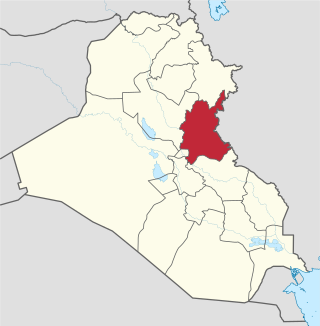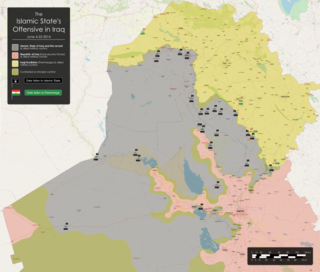
The 82nd Airborne Division is an airborne infantry division of the United States Army specializing in parachute assault operations into hostile areas with a U.S. Department of Defense mandate to be "on-call to fight any time, anywhere" at "the knife's edge of technology and readiness." Primarily based at Fort Liberty, North Carolina, the 82nd Airborne Division is part of the XVIII Airborne Corps. The 82nd Airborne Division is the U.S. Army's most strategically mobile division.

Baqubah is the capital of Iraq's Diyala Governorate. The city is located some 50 km (31 mi) to the northeast of Baghdad, on the Diyala River. In 2003 it had an estimated population of some 467,900 people.

Diyala Governorate or Diyala Province is a governorate in northeastern Iraq.

The First Battle of Fallujah, code-named Operation Vigilant Resolve, was an operation against militants in Fallujah as well as an attempt to apprehend or kill the perpetrators of the killing of four U.S. contractors in March 2004.

Ar-Rutbah is an Iraqi town in western Al Anbar province, completely inhabited with Sunni Muslims. The population is approximately 28,400. It occupies a strategic location on the Amman–Baghdad road, and the Kirkuk–Haifa oil pipeline. Considered a "wet spot", it receives 114.3 mm (4.5 inches) of rain annually, and is located on a high plateau. It has been described as "the most isolated town of any size in Iraq."

The 3rd Cavalry Regiment, formerly 3rd Armored Cavalry Regiment is a regiment of the United States Army currently stationed at Fort Cavazos, Texas.

Below is an estimated list of the major units deployed within the Multi-National Force – Iraq and other United States military units that were operating in Iraq under the U.S. Central Command (USCENTCOM) in 2009, during the Iraq War.

The 4th Brigade, 2nd Infantry Division ("Raiders") is an inactive Stryker Brigade Combat Team (SBCT) of the United States Army. The brigade was activated at Fort Lewis, Washington on 1 June 2006 by reflagging the 2nd Stryker Cavalry Regiment. The 4th Stryker Brigade had the distinction of being the last U.S. Army combat brigade to serve in support of Operation Iraqi Freedom. The brigade deployed three times in support of the War on Terror, to Iraq from 2007–2008 and from 2009–2010, and to Afghanistan from 2012–2013 before inactivating in March 2014.

The Diyala province campaign was a series of operations conducted by coalition forces against Iraqi insurgents and a number of bombing and guerrilla attacks against the security forces in Diyala Governorate of Iraq, with the purpose of control of the province.

The Battle of Baqubah II took place during the Iraq War in the capital of the Iraqi province Diyala, to the north-east of Baghdad. It began in early March 2007, when U.S. and Iraqi forces commenced preliminary operations to "establish a presence in Diyala beyond their Forward Operating Base".

Operation Phantom Thunder began on 16 June 2007, when Multi-National Force-Iraq launched major offensive operations against al-Qaeda and other extremist terrorists operating throughout Iraq. It was the largest coordinated military operation since the 2003 invasion of Iraq. Operation Phantom Thunder was a corps level operation, including Operation Arrowhead Ripper in Diyala Province, Operation Marne Torch and Operation Commando Eagle in Babil Province, Operation Fardh al-Qanoon in Baghdad, Operation Alljah in Anbar Province, and continuing special forces actions against the Mahdi Army in southern Iraq and against Al-Qaeda leadership throughout the country. The operation was one of the biggest military operations in Iraq since the U.S. invasion in 2003.

Operation Phantom Strike was a major offensive launched by the Multi-National Corps – Iraq on 15 August 2007 in a crackdown to disrupt both the al-Qaeda-affiliated Islamic State of Iraq and Shia insurgent operations in Iraq. It consisted of a number of simultaneous operations throughout Iraq focused on pursuing remaining ISI terrorists and Iranian-supported insurgent groups. It was concluded in January 2008 and followed up with Operation Phantom Phoenix.
Operation Phantom Phoenix was a major nationwide offensive launched by the Multinational Force Iraq (MNF-I) on 8 January 2008 in an attempt to build on the success of the two previous corps-level operations, Operation Phantom Thunder and Operation Phantom Strike and further reduce violence and secure Iraq's population, particularly in the capital Baghdad. The offensive consisted of a number of joint Coalition and Iraqi Army operations throughout northern Iraq as well as in the southern Baghdad Belts.
The 2008 Nineveh campaign was a series of offensives and counter-attacks between insurgent and Coalition forces for control of the Nineveh Governorate in northern Iraq in early-to-mid-2008. Some fighting also occurred in the neighboring Kirkuk Governorate.

Operation Augurs of Prosperity was an Iraqi operation against insurgents in Diyala, north-east of Baghdad. The operation was launched on 29 July 2008 by elements of at least three Iraqi Army divisions, with four U.S. armored cavalry squadrons from the 3rd Armored Cavalry Regiment and the 2nd Stryker Cavalry Regiment in support. The U.S. led operation was designated Operation Iron Pursuit and consisted of three sub-operations: Sabre Pursuit, Eagle Pursuit and Bastogne Pursuit.

The Battle of Samawah took place during the 2003 invasion of Iraq as American troops fought to clear the city of Iraqi forces. The city had been bypassed during the advance on Baghdad, leaving the task of clearing it to American paratroopers of the 82nd Airborne Division with mechanized infantry and armor provided by units of the 1st Battalion, 41st Infantry Regiment, and 2-70th Armor Battalions, along with 3rd platoon 59th Chemical Company tasked with finding and removing any potential chemical or biological weapons. The battle was the largest sustained urban combat that paratroopers of the 82nd Airborne had been involved in since World War II.

The 32nd Cavalry Regiment is a cavalry formation of the United States Army. From 1941 to 2000, it was an armor formation.

The 5th Division is a military formation of the Iraqi Army. The division is currently deployed in eastern Iraq – predominantly Diyala Governorate. Following the losses suffered by the Iraqi Army during fighting in the ISIL campaign in Northern Iraq, the Iraqi security forces became increasingly reliant on non-state militia units – the Popular Mobilization Forces. As of October 2015, Reuters reported that the 5th Division reported to the PMF chain of command, instead of the official military hierarchy.

Operation Sayeed also known as Operation Hunter in English, was a series of operations conducted in western Al Anbar Governorate by the United States Marine Corps in 2005. It was an umbrella operation, consisting of at least 11 named operations between July 2005 to December 2005. The purpose was to drive Al-Qaeda in Iraq forces from the Western Euphrates River Valley. Some parts of Operation Sayeed were Operation Steel Curtain and Operation Iron Fist.

The Northern Iraq offensive began on 4 June 2014, when the Islamic State of Iraq and Levant, assisted by various insurgent groups in the region, began a major offensive from its territory in Syria into Iraq against Iraqi and Kurdish forces, following earlier clashes that had begun in December 2013 involving guerillas.
















